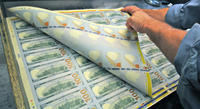-
New York firefighters receive $4.2 million to recruit volunteers

Last week the Fireman’s Association of the State of New York (FASNY) announced that it had received a $4.2 million grant from DHS to help recruit and train volunteers; the money comes as part of DHS’ Staffing for Adequate Fire and Emergency Response (SAFER) grant program; FASNY will use the grant money to launch a public awareness campaign with the goal of attracting and maintaining more than 15,000 new volunteer firefighters over the next four years; approximately 75 percent of New York’s firefighters are volunteers, but the state has struggled to attract enough people in recent years
-
-
New York ICE agent arrested for stealing and selling government property
A special agent with the Immigration and Customs Enforcement (ICE) agency was recently arrested on Tuesday for allegedly stealing government property and then selling it on eBay; the agent, Steven Kucan, was a resident of Wood Ridge, New Jersey and will appear in a federal court in Newark, New Jersey; Kucan reportedly sold approximately $37,000 worth of ICE property using an eBay account that was opened in the name of an elderly relative; stolen items include printer cartridges, camera lenses, film, combat lights for M-4 rifles, and even a special diving suit designed to prevent hypothermia in cold water
-
-
Sector Report for Tuesday, 17 May 2011: Law Enforcement Technology
This report contains the following stories.
-
-
A team of robots collaborate in exploration, map building
Researchers have developed an advanced autonomous capability for first responders, law enforcement, and the military: a group of robots, working by themselves and communicating only with one another, divide up among themselves a variety of exploration tasks — for example, they can go into a building and within minutes transmit a detailed floor map to humans waiting at a command center nearby
-
-
Infrared sensors could help police detect suicide vests
Sophisticated infrared sensors originally designed for the U.S. military could soon be used by local police departments to detect suicide bombers; Thermal Matrix USA initially designed its Access Counter IED Technology system to assist military personnel in Iraq and Afghanistan identify potential suicide bombers, but hopes to create a model that local law enforcement agencies can deploy; the company has modified its product to significantly reduce its size, weight, and deployment time to be more practical; the devices are capable of detecting any hidden objects including knives, guns, plastics, and even liquids
-
-
States turning to new "familial DNA" tests, practice faces legal hurdles
Law enforcement officials in several states across the United States are hoping to obtain the legal authority to begin conducting “familial DNA” testing, a process which could greatly increase the number of suspects identified in violent crimes; while DNA is often found at crime scenes using familial DNA would allow law enforcement officials to use DNA from a suspected criminal’s relatives to positively identify them; currently only California and Texas have laws in place that allow investigators to conduct familial DNA tests; Virginia, Pennsylvania, and Florida could soon join their ranks; the practice is still quite new and faces legal challenges and must be approved by a state’s courts
-
-
Arlington, Texas hopes to keep aerial drone
The police department of Arlington, Texas is examining ways to fund an unmanned surveillance drone; the drone was originally purchased with grant money from DHS to assist local police officers with security during Super Bowl XLV held at Cowboys Stadium in Arlington last February; the drone is still technically owned its unidentified manufacturer and the City Council is debating how to pay for the drone’s operation and maintenance
-
-
West Virginia lottery winner donates $1 million to local police and fire departments
After winning the lottery, a West Virginia resident has donated nearly $1 million to local police and fire departments; last Thursday, W. Randy Smith purchased six Ford F-350 pickup trucks equipped with snow plows and snow blowers for six fire departments in Berkeley County; Smith says he decided to purchase the vehicles after severe winter storms last year left many emergency vehicles unable to reach their destinations; Smith’s generosity comes after winning nearly $80 million last August in the Powerball lottery; Smith has also made several other donations including new four wheel drive ambulances for the Hedgesville and Baker Heights fire departments which cost $280,000
-
-
Audit finds lax security at money printing facility

The U.S. Treasury Department’s inspector general found that newly printed $100 bills were inadequately protected at Bureau of Engraving and Printing plants; about $54.4 million new $100 bills and $4 million uncut sheets of notes had “inadequate security” at a Bureau of Engraving and Printing (BEP) plant in Washington, D.C.; the production area in the Washington facility has over two dozen windows that lacked protective security features, and more than 200 employees have access to the area
-
-
Early warning system helped save lives in Japanese quake

Japan has spent millions of dollars to build a sophisticated early warning system for earthquakes and experts say that it helped save millions of lives and mitigated the damage from the 11 March earthquake and tsunami; while the massive 9.0 magnitude earthquake and tsunami flattened much of northeastern Japan, the damage would have been far worse had Japan not had its early warning system in place; the system can provide anywhere from ten to thirty seconds of advance notice before an earthquake strikes giving Japan’s residents just enough time to slow down trains so they do not derail, shut off dangerous machinery, and send people to find cover
-
-
Sophisticated new gadgets helped Navy SEALs take down bin Laden
In the daring raid that killed Osama bin Laden, Navy Seals were likely outfitted with latest in high-tech weapons and gadgets; Fox News speculates on five key technologies that could have helped the highly trained members of Navy SEAL Team 6 successfully complete their mission including bomb sniffing dogs, satellite-linked helmet cameras, and modified stealth Black Hawk helicopter
-
-
New York first in nation to deploy PLAN emergency alert system

New Yorkers will be the first in the United States to have a new emergency alert notification system available to them; the program is called PLAN, for Personal Localized Alerting Network; PLAN is a new public safety system that allows customers who own an enabled mobile device to receive geographically targeted, text-like messages alerting them of imminent threats to safety in their area; users should expect several kinds of alerts: warnings directly from President Obama, messages about immediate safety threats, and Amber Alerts about missing kids
-
-
DHS official: Muslims will not be profiled following bin Laden's death
In a recent meeting with local Muslims in Detroit, a senior DHS official assured Muslim-Americans that they would not be subject to racial profiling following the death of Osama bin Laden; last week in Dearborn Heights, Michigan, federal officials met with Arab-American and Muslim community leaders to answer any questions and address their concerns; local Muslims were particularly worried that they would be profiled as authorities were on a heightened state of awareness for fear of a retaliatory attack; to help ease fears, Margo Schlanger, the national head of the office of Civil Rights and Civil Liberties at DHS, assured Muslims that the government was not giving special scrutiny to any ethnic groups at this time, including Muslims
-
-
Students develop better security system for retailers
Northeastern University student-researchers have created technology designed to gather more meaningful information on customer habits, inventory, and fire safety in retail stores such as CVS, Stop & Shop, and The Home Depot; the students used the university library as a mock retail store; the technology they developed displays all of the information — including the location of books, computers, and fire alarms — on digitized heat maps with geographic coordinates; the system could make for a strong fire safety application
-
-
Denying foreign aid to countries with outstanding NYC parking tickets

New York City is home to 289 foreign missions and consulates, and their foreign diplomats have incurred more than $17.2 million in parking fines; these fines were issued due to safety violations, including the blocking of fire hydrants, which put the safety of NYC residents at risk; there is already a law on the books stating that 110 percent of the total unpaid parking fines owed to NYC and the District of Columbia are to be withheld from foreign aid and obligations to the countries at fault, but so far this law has not been enforced; three New York House representatives want to change that, telling other countries: pay your NYC parking tickets or forget about foreign aid
-
More headlines
The long view
Why Ukraine’s AI Drones Aren’t a Breakthrough Yet
Machine vision, a form of AI, allows drones to identify and strike targets autonomously. The drones can’t be jammed, and they don’t need continuous monitoring by operators. Despite early hopes, the technology has not yet become a game-changing feature of Ukraine’s battlefield drones. But its time will come.
